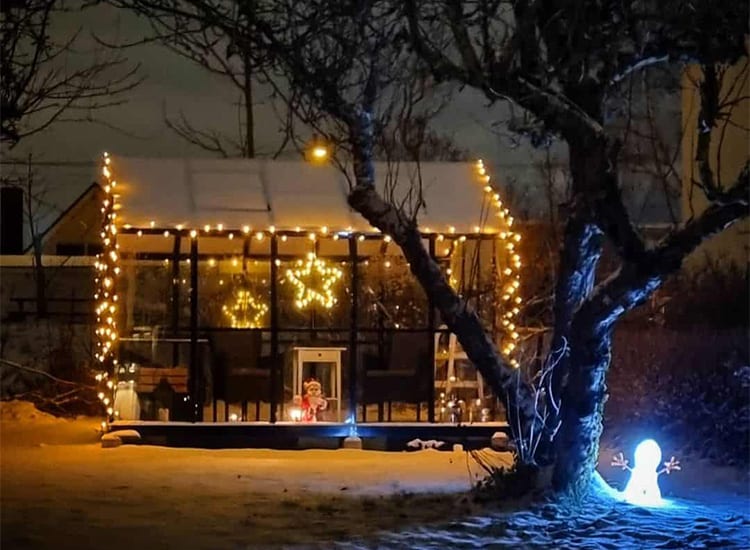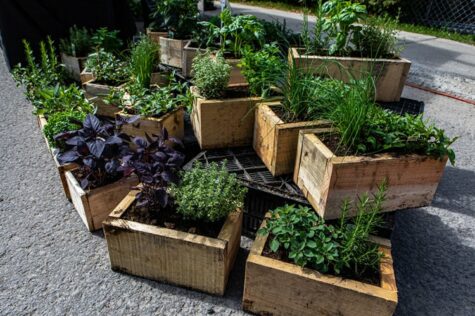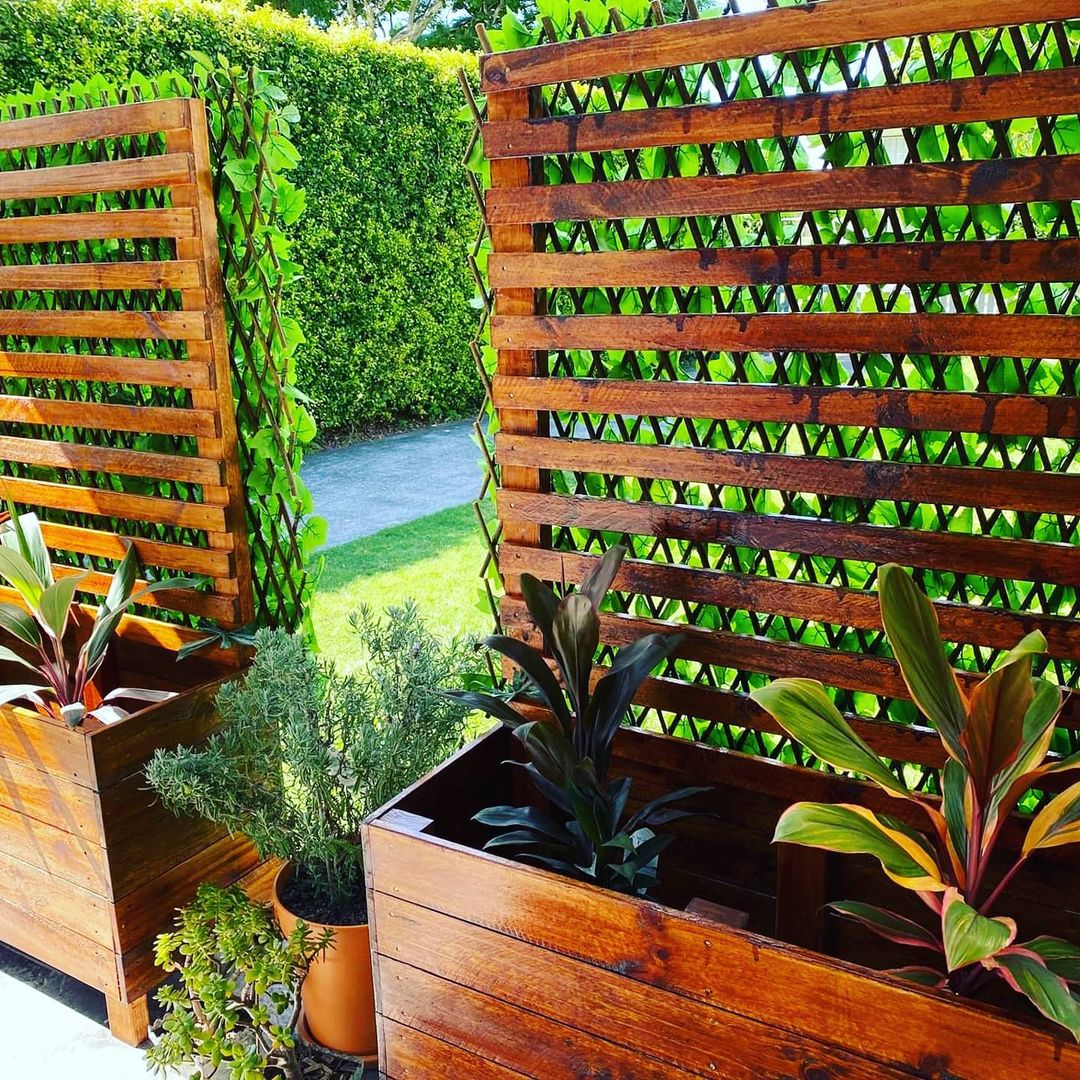Greenhouses, traditionally made of glass, provide a warm, safe place for plants that may be too delicate to survive outdoors during winter. Growing tender plants in a greenhouse planter box is the ultimate way to coddle them.
Many gardeners use a greenhouse, not only as protection for plants from winter frost and storms but also as a wonderful starting place for new seedlings. Sown inside the greenhouse, the young plants remain warm and cosy before moving outside when the worst of the cold weather is over.
A greenhouse provides a stable temperature with direct sunlight, shelter and watering systems. Growing seedlings in a planter box inside the greenhouse offers gardeners an effective way to separate plants and boost yields, while also allowing safe access for children and pets.

Fill your greenhouse with a range of planters and enjoy year-round produce. Image credit: @rebecca_anchorban_house
Why use a planter box in your greenhouse?
1. Keep things tidy
If you have younger visitors to your greenhouse, it is very easy for plants to get damaged. Space is at a premium, most plants are staked and summer climbers like cucumbers can rapidly outgrow their space.
Often there are trailing tubes of an automatic watering system curling around plant stems. So planting a few plants in a contained area like a planter box creates a tidier floor space, making it easier for everybody to walk around.
This is a plus if you have wandering cats and dogs as a physical border keeps the walkway well defined and also makes for easy cleaning and sweeping.
2. Create more space
In spring, when few plants are growing, your greenhouse will seem huge. Each year as I plant seeds and place them in the greenhouse, I forget just how little space there is by the end of the summer growing season!
A cucumber can outstrip its growing space in just 6 weeks if the weather is warm and sunny and I spend half my time in summer tying in the new growth on tomatoes and cucumbers. If the plants are growing in a planter box, they will only grow as tall as the soil conditions allow.
Unless you top up the soil fertility by feeding, a planter box may actually slow down the growth of over-vigorous plants. It is very important to revitalise the soil in planters at least every growing season to make sure it doesn’t become depleted. Use leaf mould, well-rotted manure, homemade compost and plant feed.

Keep your greenhouse tidy and you might find space for a sofa! Image credit @climapod
3. Help prevent disease
It is easier to control plant diseases if plants are in a planter box, particularly one with separate compartments, where plants can grow independently. If plants are in the ground in greenhouse soil, there is a real risk that diseases can cross from one plant to the next.
Tomato blight in one plant will spread like wildfire if your plants are in the same soil. In a planter box, you can whip out the infected plant, cover it with plastic and remove it without letting the spores spread. Dig out the section of soil it was in and discard it. If necessary, replace all the soil in that part of the planter box and don’t plant tomatoes in the same spot for at least 2-3 years. It’s never good to remove a loved plant but you will have saved the other plants by having them in a separate box.
Blight is very difficult to eradicate from the soil so digging out the soil from the planter box is easier than digging out the whole greenhouse. Cucumber leaf rot is another typical greenhouse complaint and you can remove infected leaves, check the stems and top dress the soil around them. Plants in a different planter box will not be affected. Just make sure to keep plants separate when tying in any stems.

Don’t let this disease blight your precious crops. Image credit @craftygem17
4. Improve crop yields
Growing produce in a greenhouse will mean more reliable plants and earlier crops.
If your reason for planting in a planter box is that the crop is delicate, let’s say the fussy aubergine plant, then it’s an excellent choice. You really need to water an aubergine daily in hot weather, it needs constant mulching, feeding and love and care. These plants will not tolerate cold draughts or frosty weather so being snug and warm in a greenhouse planter box suits them really well.
With different boxes, you can tend to each plant as necessary, adding mulch, setting up the watering system and easily adjusting as needed.
5. Grow food all year round
Don’t let the greenhouse sit empty in winter! The compost you used to grow cucumbers or tomatoes in summer is an excellent base for sowing winter crops. Plant basil, coriander, rocket and parsley with mizuna and winter salads for a winning combination.

An autumnal greenhouse display. Image credit: @rekha.garden.kitchen>
What materials can I use for my greenhouse planter box?
1. Wood
- Old logs cut to size. Make your wooden structure from old logs, which have more or less the same thickness, nailed together.
- Wooden pallets. You can break up a pallet and use the wood to make a variety of planters. Some gardeners place new grow bags inside the planter each year to ensure that the soil is sterile (and also hide the bag). At the end of the season, tip the soil into the raised bed and grow a winter salad crop, garlic or peas. There will still be sufficient energy for any of these crops.
- Pruned tree branches can be used to weave picket fences for the outside of your raised beds. These provide an aesthetically pleasing edge and pots can be placed behind the fence. If plants are really delicate, cover their pots with plastic in the cooler months. Delicate herbs like lovage will enjoy this treatment and you can plant them outside the following summer. You can also bend flexible branches (such as hazel or willow) over to the other side of the planter box and secure them. Cover this structure to create a tunnel of warmth for plants when snow is predicted.

Raised beds are a great option for greenhouse gardening. Image credit: @apple_acres_dk
2. Bricks
Brick is a great material for planters as the clay warms up in the sunlight and retains heat well, perfect for delicate plants. The top surface of the planter can be really useful for holding seed packets, tools, fertilisers and even a cup of tea. Build your planters to fit the length of the greenhouse on both sides, allowing space for a potting table and room for seedlings to grow.
3. Straw bales
This is a really good idea if you live close to a farm or have grassland you mow. Gather the grass to dry, wrap it with string or wire and make a wall of straw to protect the plants. It will gradually decompose so you will need to keep adding new bales but it is a great way to use grass cuttings and completely natural too. Straw provides excellent insulation and you can move them if you decide to relocate a plant.
4. Corrugated iron
If you have any spare corrugated iron sheeting, you can use this to edge a raised bed. Fix some bricks at the base inside and secure the outside with recycled hangers bent into shape or wooden stakes, to keep it steady. Fill it with soil, and your plants have a deep area in which to spread their roots and enjoy the warmth.
Greenhouse planter box plans
Here are some useful greenhouse planter box plans for inspiration.

Transform your greenhouse with a DIY planter box. Image credit: @carlasousamorim>
Are there any problems with planter boxes in greenhouses?
The only obvious one is that if slugs and snails manage to get inside, they will enjoy the regular watering and the delicious greens on offer. So remove them physically and re-locate them to your composting area or take them for a long, one-way walk to your local park.
Little gardeners will love collecting the snails and watching them in a bucket. Beware though, snails have a homing instinct! Studies have shown that snails can travel up to a mile back to their home when released far away.
I have conducted my own experiments with a daughter who banned slug pellets from the garden. We found that our marked snails could find their way home again from anything up to a mile so move them further away for any chance of success!
Can I make my own DIY greenhouse planter box?
Of course! Think about the construction of a greenhouse, then improvise with whatever materials you have. There are some other ways to protect plants in winter too:
1. Wrap trees
Trees can be wrapped in transparent material when heavy snow or frost is predicted.
- If the tree is in a pot, then move it closer to the house so that it gains some of the escaping heat.
- Next, drape the tree loosely with recycled bubble wrap. This is excellent insulation for the winter, the trapped air warms up and most trees are almost dormant in cold weather.
- Another option is curtain netting, which allows light to penetrate but takes the edge off the frost.
- Before it actually snows, wrap an old carpet around the pot, or a throw or a rug and remove it when the snow has finally melted. A few days without sunshine will not kill a tree but long-term frost and snow might!
2. Make a cold frame from recycled windows
A cold frame is a tall box with a sloping lid, much like the bins used to store salt for road spreading in winter. You can make one from old windows, and you will need to have some hinges to attach to the structure underneath.
The base can be made from anything available – straw, wood, metal, any material to keep the wind and cold at bay. Place your delicate plants in the centre, line it with bubble wrap or upcycled plastic and then replace the window lid.
- Having a hinge on the structure allows you to raise the window lid on sunny spring days and close it when the cold night air returns. Voila! Your own cold protection for your plants.

Rustle up a cold frame and protect tender plants over winter. Image credit: wiltshire_cottagelife
3. Transform a raised bed
If you have a raised bed outdoors, transform it into a mini greenhouse by making some hoops to go from one side to the other. You could use willow or flexible plastic tubes for this. These can be covered over with transparent plastic bags, bubble wrap or any transparent, waterproof material.
I have even seen an allotment owner make a roof from old CDs! It is important that light can penetrate so whatever you use, check your plants regularly and make sure it’s well secured.
Tina’s TIPS
- In spring remember to close the greenhouse door at night. Although daytime temperatures are climbing upwards, at night they drop quickly.
- Carefully check any homemade compost before adding it to the greenhouse planter box. Strain it through a sieve and remove any little visible pests before they get the chance to spoil new crops.
- Leave decoy food for pests such as comfrey leaves or nasturtiums. Usually, the slugs and snails will devour these before they start on the plants you want to protect and even if any leaves remain, the comfrey will slowly decompose adding valuable nutrients.
- Bramble deterrents. If you have any blackberries in your garden, prune some thorny stems and place them directly as a barrier against pests. The spikes are so unpleasant that most slugs completely avoid them and snails will move on to other plants.
- Silver trail searches. Get out that torch for the first few nights after new plants sprout and look for any tell-tale silvery trails from snails and slugs. Just remove them and relocate them to wilder parts of the garden or even your recycling bin, if it exists.

Your plants will be grateful for a cosy home. Image credit: @no.7_is_home
The advantages of a greenhouse are protection, warmth and an increased growing season for many plants. Building a planter box will give you the added advantage of protection for your plants where you can keep them safer from disease and enjoy the vegetables and fruit for longer. Whether it’s under glass or recycled materials, your plants will love you for it.

Save this pin for later






